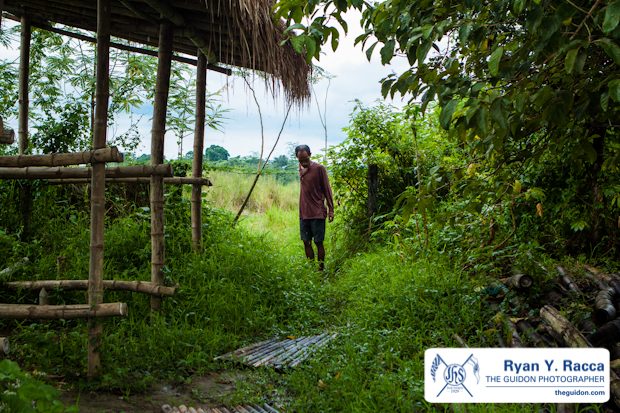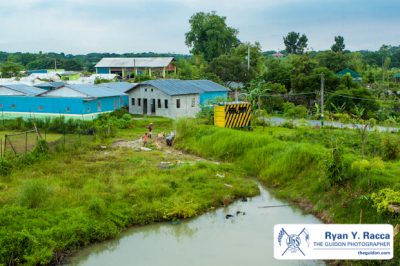
OUT OF THE CITY. A number of products from Human Nature are processed at the Gawad Kalinga Enchanted Farm in Angat, Bulacan. Photo by Ryan Y. Racca.
The Ateneo’s nation building strategy emphasizes social entrepreneurship as an integral component of its social and economic development efforts. While the strong emphasis on social entrepreneurship is a relatively recent phenomenon in the school’s long history, it is interesting to note that certain members of the Ateneo community have taken the idea to utmost fruition. Such is the case with Gawad Kalinga (GK) founder and chairman Tony Meloto (AB EC ‘71), who spends time working with Human Nature, a social enterprise co-managed by young GK volunteers.
“Social entrepreneurship is about living out the concept,” Meloto explains.
According to Meloto, products from Human Nature, which encompass a wide array of beauty products and merchandise, are engineered from local materials such as citronella oil and extracts from coconuts, rice and sunflowers. This ensures the reasonable prices of Human Nature’s products. “If your ingredients are local, how can [the products] be expensive?” Meloto says.
More than that, however, Human Nature provides sustainable livelihood for the community it works with. The enterprise employs tricycle drivers and residents from the local GK village. Furthermore, raw ingredients come from farms in selected GK communities and farmer cooperatives around the country.
Meloto says that the company has changed lives. He cites, for example, the case of the store’s workers. “[This employee] used to be a scavenger in Payatas but now earns more than the minimum wage.”
For Meloto, social entrepreneurship is all about possibilities and making these happen for the people it serves. “[Social entrepreneurship is] all about invention. It’s all about creation. It’s all about change. It’s about looking for solutions that are out-of-the-box.”
Although Human Nature has gone a long way as an innovative social enterprise, it nevertheless remains but one manifestation of social entrepreneurship in a field of diverse outcomes.
A case in definition
While the term has been used in American history and literature since the middle of the 20th century, “social entrepreneurship” broke into mainstream discourse in the 1980s when Bill Drayton founded the social venture capital institution Ashoka: Innovators for the Public. The organization aids in the financial support of upstart social entrepreneurs. Since then, social entrepreneurship has ushered in a variety of meanings that have permeated social movements in different ways.
Over the past few years, the social enterprise model has attracted great interest and attention in the Ateneo. Among its pioneers in school include the Development Studies Program, the John Gokongwei School of Management (JGSOM) and the Ateneo School of Government (ASOG).
An absolute consensus does not exist among these pioneering bodies with regard to the formal definition of social entrepreneurship. There is also belief that such a model of development is still a work in progress. “If you talk to different people, their sense of what social entrepreneurship is will be different [from each other],” JGSOM Dean Rudy Ang explains.
In that same light, Development Studies Chair Leland Dela Cruz says that social entrepreneurship is an umbrella term for a typology of social enterprises and social entrepreneurs. He likens this to the differentiation made between family and species in biological taxonomy. “What [social entrepreneurs] all have in common is that they try to address social problems, except that one perspective emphasizes coming up with new social innovations, new products, services [and] processes, and another approach would emphasize new businesses that address particular social problems.”
For his part, ASOG Dean Antonio La Viña explains that keeping the idea of social entrepreneurship inclusive is best for the time being in the context of his institution. “We cannot afford now, before so many complex challenges, to limit our solutions.” ASOG’s paradigm of social entrepreneurship is situated along a broader sense of social innovation.
For a school that is organized around the development of “knowledge leaders,” La Viña underscores the need for innovative ideas that could solve age-old problems like corruption, environmental degradation and other social challenges. “Every successful entrepreneur introduces a new idea that revolutionizes the way things are done in a sector. We need ideas, we must have new ideas, practical solutions that work and that could be scaled up.”
On the other hand, under the typological approach taken by Dela Cruz, the social entrepreneurship program advocated by the JGSOM falls under the business social entrepreneurship classification. This type of social enterprise makes social ventures possible through the utilization of business and entrepreneurial principles.
Ang, however, is quick to emphasize that the JGSOM’s paradigm of social entrepreneurship is not just about producing jobs. Rather, he argues that such has just as much to do with creating products that transform lives of people who are oftentimes ignored by regular markets.
“Social entrepreneurship is the effort to set up businesses that, either through the use of technology or by providing the right services, can not only generate livelihood, but can improve the quality of life of the community that it serves.”
“Many faces”
Although discourse on social entrepreneurship has been growing and deepening, it is of course not the only strategy in solving social problems. Dela Cruz emphasizes that social entrepreneurship is just one social development approach among many. “We should not think that any one single approach would solve all of our problems. Social entrepreneurship is a new face of social development. Social development has many faces.”
Ang likewise acknowledges that social entrepreneurship is but one option among a myriad of other social development strategies. Nevertheless, he considers it to be an important one. In fact, social entrepreneurship has been integrated in the curriculum of JGSOM, as Ang hopes to expose Ateneo business majors to various social entrepreneurship efforts. “Our effort is to let our students be aware that social entrepreneurship is a very real alternative for them in terms of career.”
Thus, for Economics Department Lecturer Philip Arnold Tuaño, it is crucial for social entrepreneurship to link up with other development strategies. While social enterprises deliver immediate benefits at the community level, there is a need to aggregate such a business model with other economic activities for greater impact and sustainability.
“These social enterprises can be linked to other economic activities of the poor. For example, you also have cooperatives [and] microenterprises that are run by the poor themselves. The question now is how to link these up so that social enterprises can contribute further.”
“Creative destruction”
According to Political Science Department Associate Professor Benjamin T. Tolosa, social entrepreneurship should not be limited to, but should rather go beyond, livelihood and economic projects.
Alluding to late economist Joseph Schumpeter’s “creative destruction,” Tolosa maps innovative ideas within the locus of social entrepreneurship. “The idea [in social entrepreneurship] is that you have someone with this new way of looking at reality, of looking at problems—could be an individual or group—and then they make these ideas become a reality so that people had not imagined this before. Something that has been considered unthinkable [and] unviable before becomes a reality.”
Through such a line of discourse, one can argue that social entrepreneurs create by destroying and destroy by creating—displacing previous ways of thinking and doing things with totally new and innovative ways of doing things.
Tolosa says that these radical ideas are made possible by generating not only financial resources but human and organizational resources as well. “An idea that used to be marginal before becomes the norm. You can’t even think of it as not having existed in the past,” he explains.
Social sphere
Referencing David Bornstein’s “How to Change the World,” Tolosa situates the emergence of social entrepreneurship along the growth of the citizen sector. “As a result of the space created for these citizen organizations, they are challenged to go beyond small-scale work so that they do something that is on the large-scale basis and [is] sustainable.”
The rise of the citizen sector could possibly be a reaction to the failure of the government to deliver services, Tolosa says. Democracy at the political level has become insufficient when the emergence of markets has shrunk the role of the government in making social decisions and providing for social needs. However, the market does not democratize resources on its own. “Because of that [market] dilemma, you have the rise of citizen organizations so that the same kind of innovation that you find in the private sector could also be done in the social sphere.”
As such, Tolosa finds that social initiatives must be connected with political transformation. For democracy to be real, one has to move to the social or economic sphere.
Tuaño likewise emphasizes that social enterprises must not be detached from political transformation. “The limitation of economic enterprises is, sometimes, they’re too absorbed in increasing income that they don’t see the link to how these contribute to political reform and decision-making in society.”
According to Tuaño, while the impact of social enterprises is readily visible on the community level, such have a bigger role in social reform. “These economic enterprises actually exist in a society where the existing social and economic structures [are] being perpetuated by people not able to participate in decision-making.”
Change-makers
In an effort to consolidate social entrepreneurship efforts in the university, the Ateneo Center for Social Entrepreneurship (Acsent) emerged through the collaborative efforts of the ASOG, the Development Studies Program, JGSOM and the Ateneo Graduate School of Business.
Formally under the administration of the JGSOM, Acsent was created to initiate and support the research, training and incubation of social enterprises in the Philippines as part of the Ateneo’s contribution to nation building.
In conjunction with the establishment of Acsent is the formation of its youth arm called the Loyola Catalyst (LC), which is a fruit of the efforts of Ateneo students.
“We’re advocating for social entrepreneurship across the student body and empowering current social enterprises through consultancy and sustainability,” explains LC President Andrew Cua.
Cua is highly optimistic about of social entrepreneurship, as it seems to offer a balance between career and social change. “Ateneans should be more involved in sustainable ways by integrating both their careers as well as their passions. In what they’re doing, everything would have a social impact.”
Last August 31 to September 2, Acsent and LC hosted a youth forum entitled “Social Change Through Business.” The event gathered leaders across the country to discuss pertinent social issues and to engage the Ateneo community in discussion about social entrepreneurship.
Dela Cruz believes that social entrepreneurship is still a work in progress. “It’s nowhere near being developed in terms of capacity-building,” he says. He believes, however, that the Ateneo has much to contribute in terms of framing the discussion and approaching it academically.
“As a social science program, we think of our program as providing the social enterprise sector the space to [strategically think] about social entrepreneurship,” he adds.
Measuring the impact
Tuaño says that while social enterprises have had significant social contributions at the community level, the impact has not been quantified yet—and even more so at the national level.
Together with other members of the academe, including Ang, Tuaño is currently working on a tool that would measure the impact of social entrepreneurship. “In many instances, these projects… have had an impact already on the community. One of the issues we’re grappling with is ‘how deep is that impact,’” he says.
However, Tolosa warns of the danger of adopting the evaluation tools of business in social enterprises.
“There’s an important need for metrics, but [it is also important] to realize that sometimes the weakness of relying too much on numbers is that people forget that sometimes the easiest to measure are not the most important things,” says Tolosa. “You cannot measure a lot of crucial things, such as changing the way people think.”

IT'S A LIVING. Residents of the nearby Gawad Kalinga village are hired to work in the Enchanted Farm. Photo by Ryan Y. Racca.
- IT’S A LIVING. Residents of the nearby Gawad Kalinga village are hired to work in the Enchanted Farm. Photo by Ryan Y. Racca.
- OUT OF THE CITY. A number of products from Human Nature are processed at the Gawad Kalinga Enchanted Farm in Angat, Bulacan. Photo by Ryan Y. Racca.


















